When we last touched on Russia-Ukraine I was criticizing the Russian Air Force for their no show in interdiction and close support. I stand by everything I wrote there, but it’s been too long since I made fun of the Western MIC, so let’s check in on the M1 Abrams tank. It sure is a wonder weapon!

The Abrams are beasts rolling over whatever is in front of their scanner sights. Get ready for the incoming kill zones you Russian Orc’s[sic]!

Hell yeah borther. If I was a Russian orc I wouldn’t want to come face to face with this MONSTROUS killing machine either.
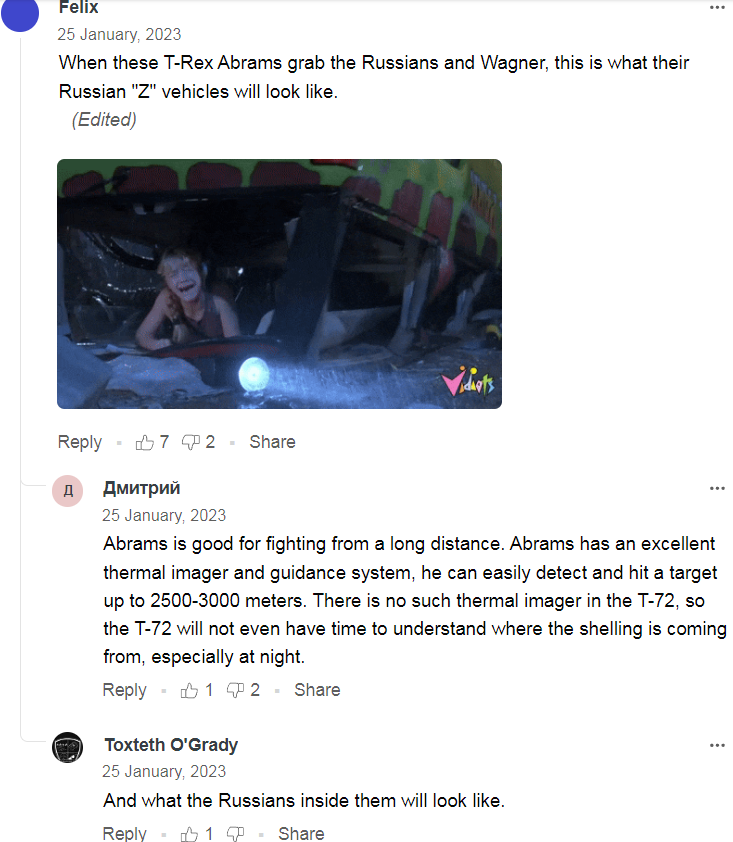
This tank is literally a tyrannosaurus rex but with thermal imaging and a guidance system. Imagine what a t-rex would do to you. Now imagine that t-rex has thermal imaging. Well, you don’t have to imagine anymore, because it’s called the Abrams.
I heard the Iraqis even started calling it the “Whispering Death,” even though this never actually happened. That’s how good it is. Nothing like that garbage T-72. Typical Russians, unable to produce a tank as beautiful and wonderful as mother Abrams. Choke on that Putler!
Send some love to the Challenger II as well. It’s still hot enough to soy out over, even though it’s no Abrams. The Abrams is a motherfuckin’ t-rex, bitch.
Now, if only President (((Blinken))) would stop being a NAZI and start sending the Abrams to Ukraine then the war would be over.
PBS:
WASHINGTON (AP) — For months, U.S. officials balked at sending M1 Abrams tanks to Ukraine, insisting they were too complicated and too hard to maintain and repair.
On Wednesday, that abruptly changed. Ukraine’s desperate pleas for tanks were answered with a sweeping, trans-Atlantic yes.
The dramatic reversal was the culmination of intense international pressure and diplomatic arm-twisting that played out over the last week. And it resulted in in a quick succession of announcements: The U.S. said it will send 31 of the 70-ton Abrams battle tanks to Ukraine, and Germany announced it will send 14 Leopard 2 tanks and allow other countries to do the same.
We did it Reddit! We defeated Putler! The Abrams is going to Ukraine.

I’m sure that –

Uh, what’s going on here? Surely these are all old articles and the –
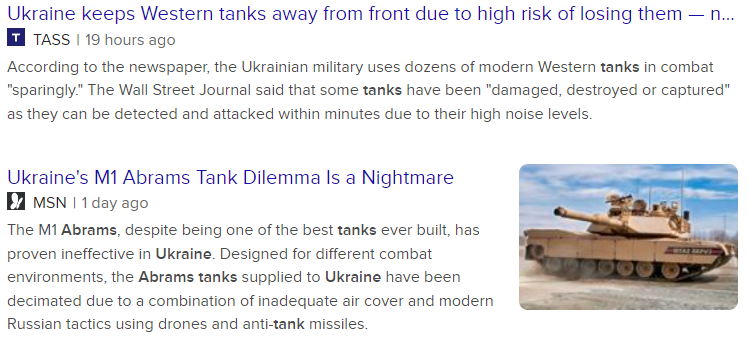
The M1 is a nightmare? Only for Putler! Our brave allies in ZOGkraine need these wonderweapons back in action, pronto.
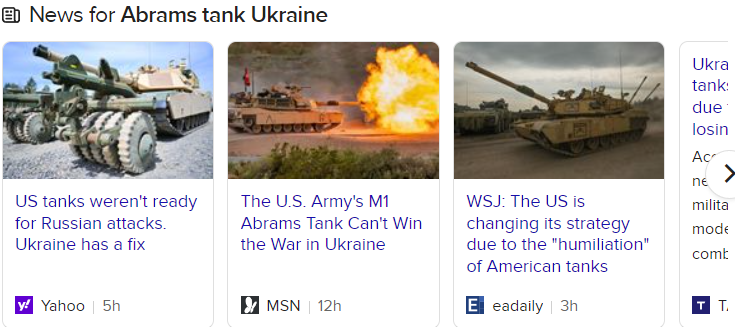
What the hell are these Russian disinformers talking about? There’s no way that the BEST TANK IN THE WORLD is being humiliated on the same battlefield where the “worse than you think” T-72 is succeeding. The Ghost of Kiev assured me otherwise.
-Out of the 31 [Abrams] tanks provided by the U.S., many have been destroyed by Russian forces using drones and advanced anti-tank weapons like the Kornet missile.
Up to date articles claim well over half.
-Incidents include tanks being hit by drones igniting ammunition compartments, and missiles penetrating side armor. As a result, Ukraine temporarily sidelined the Abrams tanks to reassess tactics.
-Despite efforts to adapt, recent reports confirm the destruction of additional Abrams tanks, leading to a dwindling fleet.
Ukraine has Leopards. They have Challengers. They have T-72’s. They have T-90’s. They never pulled any of the other from the frontline, only the Abrams. This is weird, because the Abrams is the best tank in the world. We know this, because the Military Industrial Complex constantly reminds us of this, and the only people with dissenting opinions are the ones dying in them.
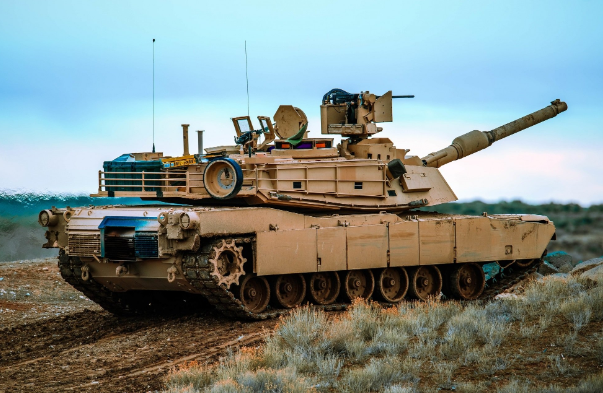
The truth about the Abrams is that there is nothing special about it, aside from the absurdly high fuel consumption. It is almost identical to the Leopard 2. It weighs the same amount. It has the exact same gun. It fires the same ammunition. It’s armoured against the same threats, and vulnerable to the same threats. However, the Leopard 2, like all other tanks, has a diesel engine, so its fuel consumption is multiple times less than the turbine engine in the Abrams, which is also a maintenance nightmare due to having to constantly clean out the engine intake filters. In short, if you took the Leopard, then massively increased its fuel consumption, logistic demands, and maintenance requirements, you’d have made the Abrams.
A PBS article written just as the Abrams was being sent to Ukraine – and hopes were still high – touched on this.
PBS:
The Abrams’ jet engine needs hundreds of gallons of fuel to operate.
It will burn through fuel at a rate of at least two gallons per mile (4.7 liters per kilometer), whether the tank is moving or idling, Butler said, which means a constant supply convoy of fuel trucks must stay within reach so it can keep moving forward.
The U.S. worried that the fuel demands would create a logistical nightmare for Ukrainian forces. While an Abrams can storm through the snow and mud, fuel trucks can’t. In addition, like any jet engine, the Abrams’ turbine needs air to breathe, which it sucks in through filtered rear vents. When those vent filters get clogged — whether by sand, as soldiers reported to GAO in 1992, or by debris they might encounter in Ukraine — they can’t perform.
I’ve talked ad naseum about military vehicles that use too much fuel. I repeat, all militaries are limited by fuel, and there are obvious tactical and operational difficulties imposed by a vehicle that consumes thousands of pounds of fuel per day. The latter is harder to quantify, but it’s not difficult to imagine the issues created bringing vulnerable refueling trucks to and fro the frontline, or cross country.
These problems were entirely foreseen, even before the Gulf War.
Again, the M1A1 was built to meet the same basic requirements as the Leopard II, but costs more, and uses 90% more fuel when driven at a constant speed (In combat, it is likely that the M1 and M1A1 would consume much more.). And the Leopard II carries more ammunition. (See chart A) A common element among cheaper, more fuel efficient foreign tanks is that they are equipped with reliable, inexpensive diesel engines, tarther than the costly, temperamental turbine engine of the M1 tank. Indeed, the M1 may be the only military land vehicle ever equipped with a turbine engine.
…
Many of the M1’s reliability failures can be traced to its turbine engine. Every other tank in the world is equipped with a reliable, inexpensive diesel or gasoline engine. Turbines are complex, temperamental and expensive. Yet the Army has been less than forthcoming in justifying the necessity of the turbine, particularly in light of its cost and fuel consumption.
…
“Today, it is estimated that one armored division equipped with M1 tanks will consume over 600,000 gallons of fuel per day, more than twice the consumption of Patton’s entire army.” (and they ran out of gas!) (p. 60, chapter 4) (an M1 armored division has 348 tanks)
…
On the contrary, Army actual use figures show that the turbine-powered M1 requires unscheduled maintenance over five times as often as the diesel M60 tank.2 Furthermore, the M1 and M1A1 tanks cost three to four times as much to maintain as does the diesel-engined M60.3 (See Chart C)
…
The turbine engine also manifests its delicate nature by requiring extra care when operating in less than ideal conditions. The M1’s operator’s manual specifically warns that falling leaves and/or snow can be sucked into the air intake during normal operations. Both can require organizational maintenance. And if the tank crew attempts to clear snow and ice from the intake system, they may damage it.4
The Abrams tank uses nearly twice as much fuel as the Leopard when driving cross country, and likely somewhere between five and ten times as much fuel when idling. This is partly due to the inherent poor performance of turbine engines at partial loads, but also because, in order to overcome the lag of turbine engines, the “military idle” setting on the Abrams is far from the true minimum RPM in order to keep the engine spinning.

Comparison of a piston airplane engine vs a turbine airplane engine efficiency. Turbine engine is the blue line. Source.
The Abrams has a 500 gallon fuel tank, and a claimed range of 250 road miles between refuelings. When idling, the Abrams consumes 30 gallons per hour, and if the tank is shut off, it consumes 10 gallons upon restart. That’s 3,375 lbs of fuel consumed in less than 17 hours when idling, and just a few hours when traveling by road.
In order to operate the Abrams on the frontline you must first have the fuel at all. Then, you must have the fuel at a nearby staging area that is safe. Then, you need enough dedicated fuel trucks on hand to deliver the fuel to the specific Abrams in their combat positions. Then, you need to have favourable terrain, so the wheeled trucks can navigate the almost assuredly cross country trip to the tanks. If all that goes right, you now get to spend 30 minutes refueling that thing in a warzone. Repeat this process every ten-twenty hours, depending on circumstances. Good luck.
Having said all that, I doubt that the Abrams is uniquely vulnerable to aircraft anti-tank weaponry. It’s difficult to imagine that the Leopard, Challenger, or any other tank fares better in that respect, and combat data does not suggest so. Ukraine has lost two thirds of their Leopards, and a great deal of their Russian made tanks. No tank has ever been invulnerable, or even particularly difficult to kill, once found and targeted with appropriate weaponry.
I think that the lack of armour excuse – on the heaviest tank in the world – is PR speak. “We just need to reconfigure the armour a little,” sounds better than “this tank has zero advantages over our other tanks, yet it’s a fuel consuming whore and maintenance princess.”
Let’s see what the Ukrainian troops have to say.
CNN:
“Its armor is not sufficient for this moment,” said one crew member, callsign Joker. “It doesn’t protect the crew. For real, today this is the war of drones. So now, when the tank rolls out, they always try to hit them.”
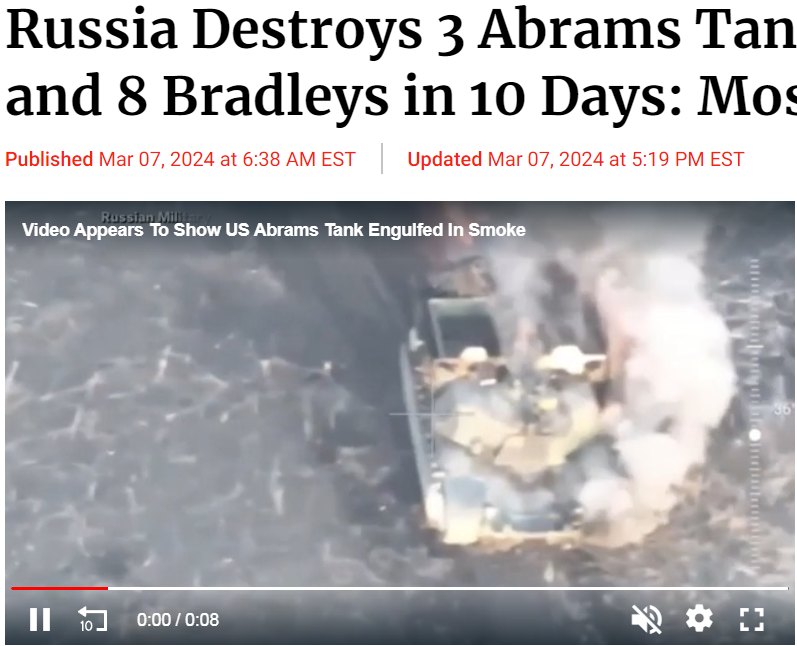
150,000 lbs sure is a lot of weight to not actually protect the crew against a single Kornet missile.
His colleague, Dnipro, added they are the “number one target.”
“Without defense, the crew doesn’t survive at the battlefield,” he said.
The crew showed CNN their attempts to affix active armor to one damaged tank. They used plates of plastic explosive that, when hit by a round, detonate and provide a protective counter-blast.
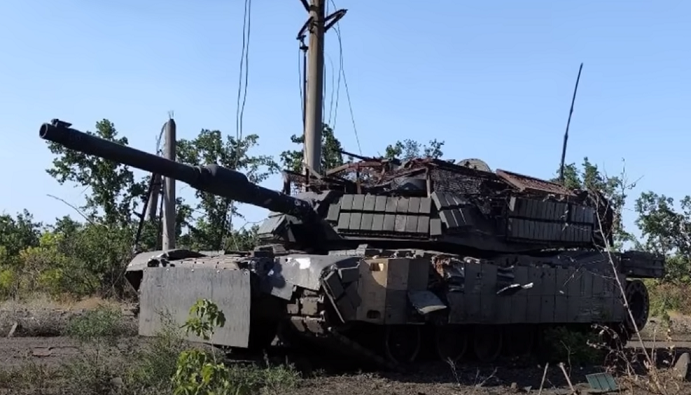
I question the efficacy of this.
For the record, none of the western tanks are designed with explosive reactive armour, yet in a real war against a real military, the belief of the troops who will be dying in these vehicles is that they need ERA. They may not be correct, but it is their lives on the line, so I trust their judgement more than the glorified General Dynamics salespeople in the US Military.
This Ukrainian crew have learned of the Abrams’ limitations the hard way, in pitched battles around the town of Avdiivka, which Russia finally took control of in February. A driver lost a leg when the armor was penetrated. Yet it is not just innovation that is hamstringing the tanks — they appear to have technical issues too.
One, parked under a tree, was almost immobile during CNN’s visit, due to an engine problem, the crew say, despite the vehicle having just been shipped in from Poland. They also complain of how, in rain or fog, condensation can fry the electronics inside the vehicle.
The Abrams defeated by it’s mortal enemy, condensation. Snark aside, this next part is important.
Ammunition is also a problem, like elsewhere on the Ukrainian frontline. They say they seem to have the wrong type for the fight they are in.
“What we have is more for direct tank-to-tank fights, which happens very rarely,” Joker said. “Much more often we work as artillery. You need to take apart a tree-line or a building. We had a case when we fired 17 rounds into a house and it was still standing.”
The tank’s poor performance has been mocked by Russian analysts, dubbing them “empty tin cans.” One model was captured by Russian forces and, damaged, paraded in Red Square.
He’s probably referring to APFSDS rounds, which are essentially giant darts. They’re good for direct hits on heavily armoured tanks, and next to useless against anything else. If you have infantry out in the open and fire a dart at them, you have accomplished little more than if you fired one single 50 cal bullet at them. In short, it’s an absymal anti-personnel round, and while a HEAT round is better, it’s still far from ideal.
The same is not true for a high explosive round, which is great against infantry/bunkers, or a canister round, which is good close range. The Abrams has both of these anti-personnel/utility rounds. That the US Military Bureaucracy predominantly sent them in with anti-tank rounds is an astonishing display of incompetence. Either they expected the Ukrainian tanks to spend most of their time dueling Russian tanks, something that almost never happens, or they felt that avoiding the negative PR of Russian tanks blowing up Abrams tanks was worth more than the actual efficacy of the tank itself in real combat.
In other tank related news, the US Marine Corps is getting rid of their tanks as part of their “Force Design 2030 plan,” which changes the USMC mission to holding dozens of tiny little islands with a battalion (~500 guys) of marines and a dozen anti-ship missiles for area denial. It’s the US Military’s version of what the Houthis are doing right now in the Straight of Hormuz.
Whether that is or is not a good idea, there’s no way for what is essentially a guerrilla force to be resupplying an Abrams tank with thousands of pounds of fuel per day, even ignoring the practical difficulties with getting such a behemoth onto the island in the first place. After all, no helicopter can carry 150,000 lbs, no heavy strategic airlifter can operate from an aircraft carrier or land on a tiny island, and it’s an enormous burden on the Navy’s limited LCACs to transport these things to shore.
Getting rid of the Abrams was a no brainer. Getting rid of all tanks is more questionable. The top comment under a piece shilling for “Force Plan 2030,” is from Jason Gilber, a (claimed) former USMC M1A1 tanker, who states the obvious.
PROBLEM: The USMC went from “wrong tank” to “no tank”. That’s what happens when the pendulum swings too far one way…it swings too far the other. As a former Marine M1A1 co cmdr, that tank was overkill & too expensive/heavy/logistical footprint, and lacking in the close support role. My calls for a very highly survivable, light, cheap, low tech tank that would support infantry were unheeded, and now we have NOTHING.
ERROR: Too many (like those quoted in article) think the tank’s main mission is killing other tanks, but since we have other ways of doing that, there’s no need for tanks. That’s like saying the mission of aircraft is to kill other aircraft. No, the chief benefit of aircraft is CAS. Other aircraft try to shoot them down, and so our fighters fight their fighters, to protect the CAS. (I don’t blame them for thinking this about tanks…my calls for more infantry support focus were unheeded, because driving fast on flat, open terrain was “badass”. Less glamorous infantry support “sucked” and “hard”. Our obsession with a tank killing focus has given everyone this wrong impression.)
Former US infantryman and military author Christopher Larsen makes the same point in this video.
15:10
Larsen: Maybe it’s not one or the other. Do we have tanks that are primarily or uniquely for infantry support? Well as an infantryman I can tell you that would be very welcomed. Because most of the tanks are geared up to kill other tanks, and they don’t get that opportunity very often, so they’re relatively useless as far as I’m concerned as an infantryman.
Seriously, that’s a harsh thing. I hold cavalrymen in very high regard, but I gotta say, their weapon is so geared up for one specific fight, one specific fight, it’s like watching jousting I think. If you were a pikeman, you know a spearman in medieval times and you’re watching your knight go “watch how cool I can knock this other knight off this horse,” and you’re going “that’s absolutely useless for me in battle.”
There is this bizarre notion that the purpose of a tank is to destroy other tanks. I’ve even heard some people explicitly say that “the best anti-tank weapon on the battlefield is the tank.” This isn’t particularly logical when we have dedicated anti-tank weaponry, nor is it reflected in any data from any real world wars. In Ukraine, almost two thirds of their Abrams have been destroyed, yet there is only one single claimed kill from another tank.
Infantry, aircraft, and ground based vehicles with anti-tank missiles, alongside artillery, anti-tank mines, and even terrain manipulation are far more relevant at defeating enemy armour than dueling them with our own tanks. Searching for “Russia Ukraine tank duels” returns almost no results, aside from erroneously labeled videos, often with thin skinned vehicles coming under tank fire, or even just tanks firing at infantry.
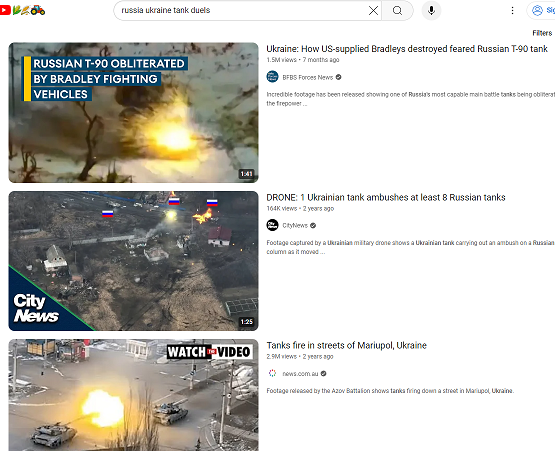
Tanks are seen as a nations premier warfighting machines, alongside jet fighters. As a result, they are compared against each other far more often than supply trucks, jeeps, transport helicopters, or other vehicles. It’s difficult to figure out the value of a tank, when factored into the military as a whole. However, it’s trivially easy to calculate the penetrative power of the tanks cannon, compare that to the frontal armour of another tank, and conclude that one of the two tanks is better than the other, because it has more armour and a bigger gun.
You could claim that your country’s tank is better than another’s because it is mechanically reliable, easily air dropped, appropriately armed, intelligently armoured, fuel efficient, and can be counted on to be where it needs to be supporting the infantry in their fight mostly against other infantry. However, that doesn’t have quite the same ring as “my country’s tank is better than yours because mine has a FUCKING HUGE COCK CANNON and FUCKING LOTS OF MUSCLES ARMOUR and if the two of them were facing each other on a featureless plain at five kilometers distance with absolutely no infantry, artillery, aircraft, or anything else complicating the issue, then your tanks tiny, soft, flaccid cock cannon would barely penetrate two inches against my tank, TWO INCHES LOSER, meanwhile my tank’s THICK, GIRTHY dick cannon would get BALLS DEEP inside the UNPROTECTED PUSSY ARMOUR of your WEAK, FEMININE TANK, and you will be greatly humiliated.”
This is basically the level of analysis that we’re dealing with here. A bunch of imbeciles using tanks as dick substitutes insisting that we give them comically oversized cannons that serve no real purpose other than to perhaps penetrate the frontal armour of another massively oversized tank. Then throwing on comical amounts of armour to theoretically stop another tanks cannon from the front. Tanks are a symbol of our nation’s pride and fighting prowess, therefore we must pretend that ours is an indestructible superweapon that shoots tactical nukes.
The real purpose of tanks is to be precise, direct fire artillery that can quickly destroy enemy targets, mainly infantry, and are capable of achieving this because they’re not twenty kilometers back firing shells that take over a minute to land. We need tanks because trying to set up a towed howitzer in the presence of the enemy can be mighty impractical. 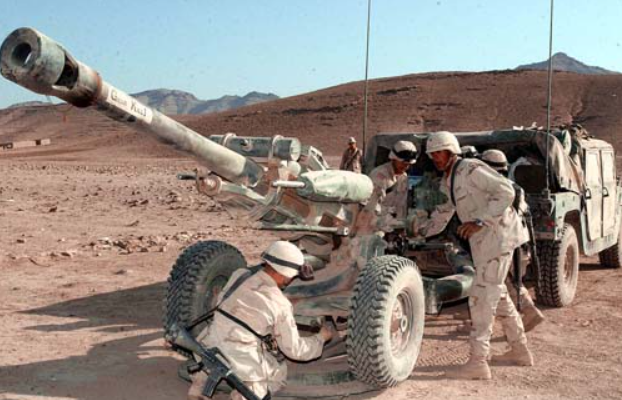
A self propelled direct fire artillery piece with a heavy machine gun, armoured against anti-infantry weapons, is not an indestructible super weapon. It is however, a useful weapon, to be used in conjunction with our infantry in their fight against the enemy. Infantry in bunkers, fighting positions (glorified holes), or using trees or other objects as cover are very effective against our guys with rifles, but entirely ineffective against the cannon of our tanks, which can also destroy any thin skinned vehicles that they come across. Again, the point is precision artillery.
This is more than enough to be useful, but once you start calling something a “light tank,” retards start whining about how it isn’t an invulnerable superweapon that can win you a war all by itself. That’s why – and I never do this – I have to commend the US Military Bureaucracy for their “Armoured Gun System” moniker. What is an “Armoured Gun System” (AGS) you ask? Well it’s definitely not just a light tank with some PR.
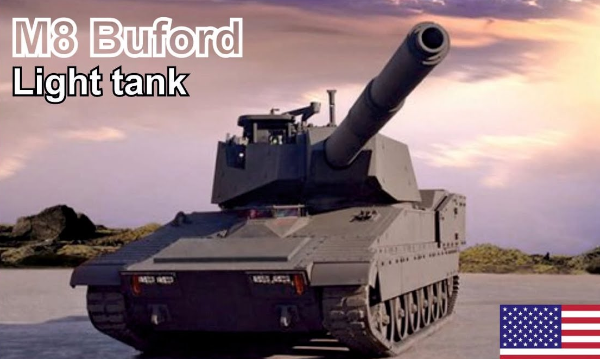
Can you believe that some ignoramuses believe that the M8 Buford is a light tank? Sure, it has a tank cannon, armour, tracks, and a turret, but that clearly marks it as an armoured gun system, instead.
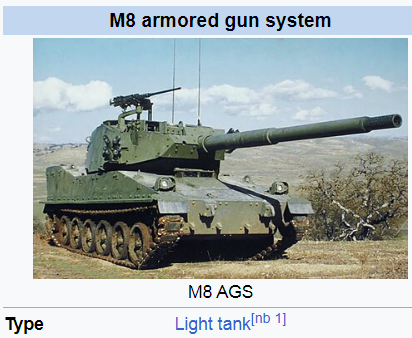
Can’t believe Wikipedia labeled this “light tank.”
The M10 Booker, pictured below, is also very clearly an armoured gun system.
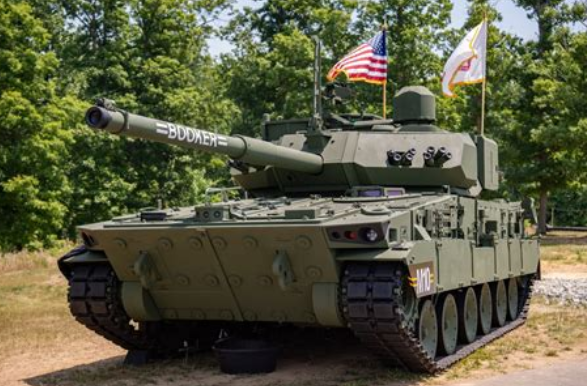
M10 Booker
Get a load of this big, beautiful light tank Armoured Gun System. It’s really nice to have a purpose built light tank AGS, unlike the Stryker light tank AGS that was cobbled together out of necessity.

Due to the fact that these vehicles are in fact not light tanks, but rather a whole new thing, they don’t need to be (imaginarily) indestructible, or be able to penetrate the armour of some super heavy 75 ton Main Battle Tank. You can’t expect an artillery piece to be indestructible, and you can’t expect it to do everything. That would be like asking our supply trucks to be indestructible!
I can’t stress enough that I’m only somewhat poking fun at this “Armoured Gun System” nonsense. The US Army has found a way to politically sidestep the idiots who think that the purpose of a tank it to duel other tanks, and are free to build a vehicle that actually helps win wars instead. That’s a not insignificant political achievement.
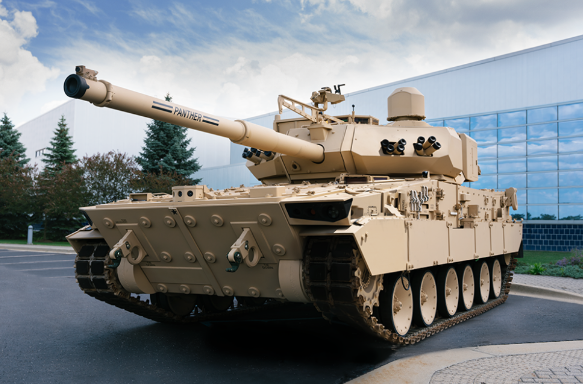
M10 Booker
So of course they used this freedom to make the M10 Booker, a 90,000 lbs non-airdroppable behemoth uncarryable by any helicopter, and firing a massive 105mm cannon, which is overkill for soft targets, yet underkill for heavy tanks. They went for this, despite the M8 Buford, a proven design, existing for decades at half the weight.
TWZ:
GDLS’s entry was based on the company’s Griffin II with a turret derived from the one on the M1 Abrams tank. BAE Systems’ entry was based on the M8 Buford Armored Gun System (AGS) light tank, which was developed for the Army in the 1980s under a separate program that was ultimately canceled in 1996.
We spoke with an active duty Army master gunner familiar with the MPF development process who expressed concerns about the GDLS version and said there was much to like about the BAE Systems’ [Buford] entry.
It was lighter than the GDLS version, weighing in at less than 20 tons in its lightest configuration. Equipped with an autoloader, it had a smaller crew – three compared to the GDLS’s model. Most impressive, however, was the ease of repair, the soldier told us.
“The engine access was a lot better” in the BAE Systems’ vehicle, he said. “It was more conducive to a light unit.”
“You could just slide the motor out and work on it, which is important for light infantry in an austere environment,” the soldier told us. “It didn’t need the requisition of overhead lifts to work on it if something catastrophically breaks.”
By contrast, the Booker requires a vehicle like an 8×8 Heavy Expanded Mobility Tactical Truck (HEMTT) equipped with a crane to lift the motor out if that level of repair work is needed, the armor expert explained to us.
I’m scratching my head wondering what the hell they’re getting for all that weight. It has to be something really good in order to –
The M10 Booker prioritizes crew protection, boasting armor that can withstand 30mm Armor-Piercing Discarding Sabot (APDS) rounds when facing the front and 14.5mm Armor-Piercing (AP) rounds on the sides. Additional armor panels and underbody protection guard against improvised explosive devices (IEDs), enhancing the vehicle’s survivability on the battlefield. The crew’s safety is further ensured with a compartmentalization system that has undergone rigorous testing to secure ammunition storage.
It weighs 50,000 lbs more than the M8 Buford. It can’t be airdropped, uses more fuel, is harder to maintain, and has worse cross country mobility. This was necessary for us to meet the crucial “armoured against 30mm APFSDS rounds from the front” criteria.
I touched upon this when writing the “Modern Fighter Planes are Jokes” series, but armour starts getting arbitrary past small arms. It is well known the amount of armour required to stop a 5.56 round. The same is true for 7.62, 40mm grenades, or even 50 cals. Additionally, these are fixed targets. Infantry cannot use larger anti-infantry weapons, because those are heavier. Since those are going to be the main weapons already in a firefight, it makes sense to build an armoured vehicle resistant or hopefully even immune to these weapons. For practical reasons, the enemy is stuck with these weapons, so once we have our level of protection chosen, we can count on that. Also, these are the lightest weapons, so the weight of the armouring is relatively minimal.
The same is not true for ATGMs, mines laid by a real military (not the ghetto anti-tank mines of the Taliban), or any other anti-tank weaponry, with the debatable exception of recoilless rifles. The size and power of the warheads on these things are not nearly as limited by practical weight concerns. If our 100lbs Hellfire anti-tank missiles stop doing the job, our aircraft could easily fire a 200lbs version with a larger warhead. Armouring our vehicles against anti-tank weaponry, or anti-aircraft weaponry, is a Sisyphean task.
But there is another reason why armouring against anti-infantry weapons is so practical. There are a ton of infantry, and therefore far more rifles than tank cannons, or ATGMs, or 30mm cannons that shoot APFSDS. Armouring against up to 7.62mm rifles alone protects us against the vast majority of threats on the battlefield. Armouring us against 30mm APFSDS armours us against, what, 0.1% of the weaponry that we will face?
What shoots 30mm APFSDS other than the BMP? How many BMPs are we expecting to face specifically from the front area only? What percentage of those BMP cannons will be loaded with APFSDS, which is totally useless against infantry? What percentage of these cannons will be located in such a position where they can only shoot our frontal armour, instead of hitting us from the side, rear, or top?
We’re still vulnerable against all real anti-tank weapons. We’re still vulnerable to a heavy tank cannon. We’re still totally vulnerable to aircraft. We’re still vulnerable to near misses from heavy artillery. However, if the enemy starts dueling us in their BMPs, then we might come out ahead, if conditions are perfect. Was it worth 50,000 lbs to go from being armoured against 90% of the enemy’s weaponry, to 90.1%?
The US MIC is incapable of building anything that doesn’t weigh easily twice as much as it ought to. If they made a new assault rifle it would probably weigh 15 lbs and fire some weird, unique ammunition that messes with logistics just to have worse performance in real combat.
Oh wait. They did exactly that.
A retired US Marine makes most of the same arguments I do here.
An Interlude Where We Rant About the XM-7
The US Military Industrial Complex decided to create a replacement for the AR-15 derivatives that shoot 5.56. The war in Ukraine has once again shown that volume of fire is paramount, light weight is key, and marksmanship is irrelevant. So of course they decided that the next infantry rifle should be heavy, with low volume of fire, but “make up” for this by theoretically being a better sniper rifle.
That might sound bad, but don’t worry, the overweight rifle has “overmatch” against 5.56 rounds in the scenario where two soldiers are sniping at each other over wide open terrain from more than half a kilometer away. I hear that happens a lot in the ninth generation battlezone after sensor fusing force multipliers with full spectrum integrated lethality through combined arms highly concentrate distributed firepower, or something.
The impact on whatever they hit will be fearful. The furthest targets we fired at were backed by cinder blocks. Prior to pulling the triggers ourselves, an Army marksman took aim at the 600m range – first with an M4, then with the XM-7. The M4 pock-marked the blocks but did not penetrate them. The XM-7 rounds went right through, cracking the blocks, leaving large holes and in a couple cases smaller, clean entry and exit points.
The guns will evolve although exactly how isn’t clear yet. What’s clearer is that their step-forward in capability will drive an evolution in Squad, Company, and Brigade tactics, techniques, and procedures. Army soldier formations will fight the same but differently with the XM-7 and XM-250 – standing off at longer ranges, knocking down targets they could previously only slow and turning what was once effective cover (cinder block walls, plate steel and other obstructions) into mere concealment.
We’ve got soldiers hip firing in Ukraine. Meanwhile, the US Military is bragging about their new rifles ability to accurately penetrate cinder blocks at more than half a kilometers distance.

The justification for this heavier round, in addition to better marskmanship, is mythical Russian/Chinese body armour that apparently covers their entire bodies now and is invulnerable to 5.56. Yeah, okay bro. A chestplate weighs 20lbs. If they were to magically cover their entire bodies with armour, they would weigh north of 150lbs. If they did that, we wouldn’t even need to pin them down, their body armour is doing that for us. At that point, fire some mortars at them, in combination with the 7.62 that we already carry, and that’ll take care of these guys real fast. Or light tank AGS rounds. Or towed artillery. Or aircraft. Or…
By the way, if they were carrying that much weight in body armour, they wouldn’t even be able to do short hikes, so they’d never be where they need to be anyway, and could be outmaneuvered by walking around. Imaginary soldiers invulnerable to 5.56 is something conjured up in the minds of military bureaucrats looking to justify a new boondoggle, and mindlessly regurgitated by NPCs who enjoy uncritically consuming propaganda.
I can’t really sum up this nonsense more than a comment from “ruslanmarynych8883” on the video.
A comment from Ukraine, where I do know the theatre quite well.
1. Ammo/small mag – it’s critical issue. Often times you can’t clearly see the enemy due to vegetation and terrain, and the engagements can take the WHOLE day long, and you even need MULTIPLE AKs to go through the fight while being able to return fire, because they will get dirty and unoperational from such an intensity, I’m not even mentioning how many MAGS you’d actually need.
2. Armor penetration/High velocity – it seems logical, but it’s wrong direction, IMHO. To prove on my point – in case of a large-scale conflict, your M4 or AK is not going to earn most of kills – it’s going to be the in 80% of cases – other weapon systems. Most of the casualties are here from artillery, mortars, tank fire, MRLSs, etc., so your body armor should be definitely not a modern cool JPC 🙂 And what’s saving your life is your mobility, tactics and training, not the body armor. What’s even more illustrative – most of wounds are going to legs and arms, body armour isn’t saving here, and your cartridge with greater armour penetration – won’t help you in this scenario
“Lethality” is a debatable topic – wounded enemy is a bigger problem for him, his team mates and medics, he’s unlikely to return fire, but needs the attention of his team mates takes multiple enemies out of fight, based from what I see.
3. Weight – as you can get from my last point – you need to have a good body armor, it’s not going to be super-light for sure, it’s going to have a lot of kevlar, thus – your mobility will suffer, based on my 1-st point – you need to have a lot of ammo on you, and adding very diverse weather and terrain in Ukraine – you are getting very heavy + it’s very likely you’d carry some anti-armour weapon with you at FIRE TEAM level, or even multiple ones per fire team. And XM5 fire here with all of that weight? It’s just adding an insult to an injury.
4. [Distance] – you’re right here, in large scale war, your personal weapon is PDW, nothing more than that, perfect way to describe it!
[snip, more of the same]
5. Optics – that’s true, there are only obscure scenarios when you can notice an enemy in our terrain 700-800 yards away and engage him with your personal weapon, no optics has an ability to look through the vegetation and the enemy isn’t going to run through the plain field – he’s going to be engaged by other weapon systems there, that have longer range and fire superiority. Vegetation is even causing problems for thermal vision systems, who are really the best system that gives the most advantages in this war – your situational awareness using drones and observation systems is key, not the personal weapon optics.
The soldiers only have a vague idea where the relatively close enemy is. So of course they need better marksmanship, and lower volume of fire, so they can accurately fire at semi-random positions, instead of sending a spray of bullets downrange, or into the trench that may or may not be empty. Remember, infantry always have a perfect understanding of where the enemy is, because they have magic x-ray blood seeking vision.
Here’s a much shorter comment from @Chiller01,
Here’s another from “ArchAngelLevon”,
The Good:
Bigger round, heavier bullet, spicier load, longer range, more energy, better lethality, flatter trajectory.The Bad:
Physically larger munition, heavier, lower same-weight/bullet ratio, heavier gun, increased recoil, new project means slower production, no aftermarket, jacked pricesThe Ugly:
Soldier combat-loads have been increasing and never decreasing since the dawn of time, with modern soldiers carrying a literal house on their back, a cookware set on their chest and a brick in their hands at all times. Any added weight is NEVER appreciated and is, in fact, massively detrimental. Especially in the weapon itself.Future was supposed to make everything lightweight carbon-nanofiber and easy to carry. But whatever, just throw another 2 pounds onto our warfighters.
Just carry more shit, faggot.
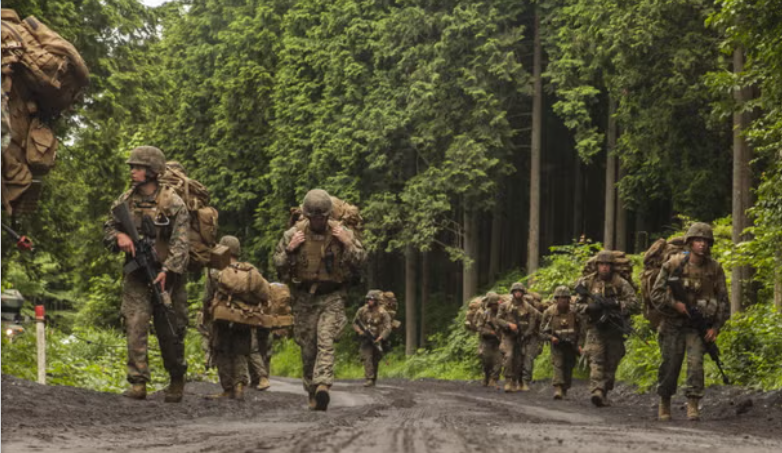
The accuracy and long range ballistics of the assault rifle is almost irrelevant, because the soldiers can’t hit shit anyway. They can’t hit anything, because they only vaguely know where the other guys are. Sometimes they might see a muzzle flash. Sometimes they might see some movement. Sometimes they’re just firing in a general direction. Marksmanship is irrelevant when you’re firing into a tree line, clearing a trench, clearing a room, etcetera. If that wasn’t how combat worked, then the default rifle would be the sniper rifle, and the assault rifle would be the niche weapon, instead of the other way around.
Besides, simply suppressing the enemy until the general purpose machine pun (GPMG), or any heavier weapon such as artillery, can be brought to bear on the enemy is all these guns need to do. Even at the lowest level, the infantry do not lack for firepower.
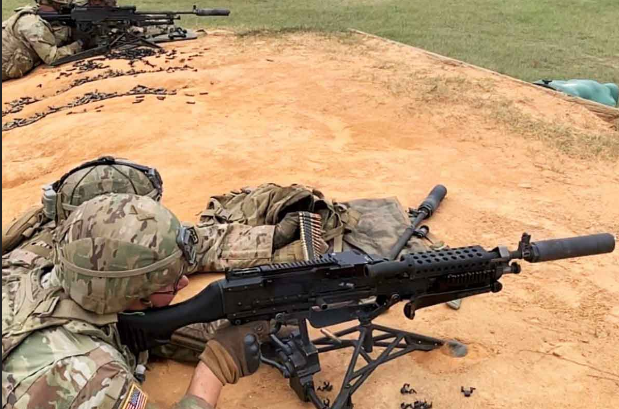
M240
Jeff Gurwitch, the maker of the video critical of the XM-7, talks in detail about Taliban ambushes. Basically, the idea is that the Taliban would often occupy premade firing positions, armed with GPMGs, and occasionally anti-armour weaponry, open fire from ~700m away, then fall back. Therefore, on a man to man basis, their GPMGs laid down more effective firepower than the army’s 5.56mm rifles.
Because, like, no shit.

The lesson that the military learned from this should have been better recon and infantry tactics to avoid ambushes, and better vehicular support, such as a real CAS prop plane capable of already flying in the area, to provide the quick responding mobile firepower to overcome said ambushes, in addition to helping with recon. Instead, the lesson is apparently that getting ambushed constantly is no big deal, as long as the light infantry magically have higher quantities of more appropriate firepower than the guys in the pre-built, well supplied ambush site. Even though they still won’t have that with a 6.8mm rifle versus a GPMG anyway.
But don’t worry, our boys can always occasionally rely on air support from an F-16 jet at an airbase 400 km away, wait thirty five minutes for it to show up, and cheer as they drop bombs on positions the Taliban retreated from 20 minutes ago. Repeating this process for twenty years before leaving Afghanistan is the height of military genius.
For the record, if the average US infantryman ditched their effective close quarters M4/M16 assault rifle for something ridiculous, like 33lbs M82 sniper rifles, it’s likely Taliban would have stopped ambushing them from 700m, and started ambushing them in close. I’d much rather be ambushed from 700m, than 7-70 meters. So even when the 5.56mm rounds were sub-optimal, they still discouraged the enemy from a potentially far deadlier plan of attack.
By the way, one of my buddies who actually served in the CAF in Afghanistan told me that they were under strict orders to never leave base unless they could guarantee a 30:1 numbers advantage for that mission. In other words, if you expect to meet a 10 man squad, bring the majority of a 500 man battalion. That way the 10 Taliban fighters in the specific area you’re occupying would be hopelessly outmatched should a fight break out.
Meanwhile, the Taliban in the other 29 areas you could have been, had you spread out your forces, are laying the next round of roadside mines, building the next machine gun ambush positions, and digging holes in semi-random spots in the cold Afghanistan mountains to sit in for weeks with a good enough sniper rifle in case any patrols come through.
The lesson learned was to have an oversized rifle.
Our friend Task & Purpose also has a video on the XM-7. He uncritically repeats the eye rolling nonsense about cinder blocks being holocausted from six hundred meters, along with some heavily cherrypicked comments from the soldiers who were chosen to fire this weapon. He also says this.
But not everyone is convinced that the XM-7 and the new caliber represents an upgrade. Critics of the rifle choice argue that the new platform, optic, and caliber trade too much of that close combat performance for long range punch. They say that the lessons from the war in Ukraine might suggest that trench warfare might be less than ideal for this weapon system like the XM-7 with its higher weight, higher recoil.
But according to the US Army’s new FM 3-0 Multi-Domain Operation Doctrine, the US Army wants to avoid ever even getting dragged into a trench battle in the first place. That they would want to continue to maneuver instead.
“We’ll just never do trench warfare.”
Okay, good luck with that.

In fairness to T&P, he points out that the feedback given by the troops, while usually something someone actually said, is entirely cherrypicked. It’s like how every terrible movie finds that one critic who says “nonstop laughs,” so they plaster that over their posters, instead of the other thousand critics who said “wtf that was the dumbest shit I ever saw. So fucking bad.”
The comments under T&P’s video are interesting. I have no way of verifying that these people are who they claim to be, of course, but they do give me that confirmation bias high that I’m always craving.
From @methodsocratic,
Former Navy public affairs officer here – TLDR, this is 100% NOT what soldiers really think of the XM7. Officially released troop “feedback,” quotes given to “Stars & Stripes,” these are all carefully managed by DOD PAOs (public affairs officers). It’s called “command information,” aka, propaganda. Info produced for public release won’t contain factual errors…but it (generally) will also never include negative criticism.
From skatedude74,
Them brushing off the weight is concerning and that officer saying “just work on your biceps” shows he doesn’t even understand the problem.
Yeah bro. The problem isn’t that we’re making you carry an oversized rifle with less ammunition for seventeen straight hours of urban combat. The problem is that you haven’t done enough biceps curls.
User southernSCkid,
As a soldier in the 101st on the ground with these weapons I can say the attitude towards the xm7 is NOT a positive one. Most people agree that it should be in an SDMR [Squad Designated Marksman Rifle] position. The 250 however is a welcome change, love it.
If anything, the problem with 5.56 is that it’s too big, not that it’s too small. If the Military was serious about winning wars, instead of lining the pockets of “defense” corporations, they’d create the lightest round that was still effective, to be fired from the lightest rifle possible. That gun would have a high fire rate, and a very large magazine size. The infantry could carry more ammunition, or choose instead to remain less burdened by weight.
Although it’s questionable if the logistical problems created by having an entirely new rifle caliber would be worth it, even if the new rifle was superior.
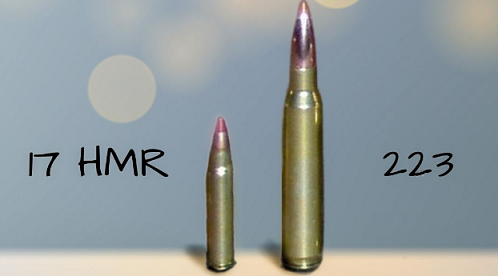
17 HMR is almost certainly too small, the point is that something in between could be feasible.
However, the only reason that NATO uses 5.56 was because the US Military saw the failure of their golden child, the M-14 shooting 7.62, in action. They were forced to go to a smaller rifle/caliber, but did their best to have the absolute most retarded criteria possible for said caliber.
The 7.62x51mm cartridge (which is more similar to the .308 than the 7.62x39mm rounds used in Soviet AKs) actually remains in use today thanks to its stopping power and effective range, but it wasn’t long before even the 7.62’s biggest champions in the U.S. began to recognize its shortcomings. These rounds were powerful and accurate, but they were also heavy, expensive, and created a great deal of recoil as compared to the service rifles and cartridges of the modern era.
As early as 1957, early development began on a new, small caliber, high velocity round and rifle platform. These new cartridges would be based on the much smaller and lighter .22 caliber round, but despite the smaller projectile, U.S. specifications also required that it maintained supersonic speed beyond 500 yards and could penetrate a standard-issue ballistic helmet at that same distance. What the U.S. military asked for wasn’t possible with existing cartridges, so plans for new ammo and a new rifle were quickly drawn up.
What the hell does penetrating a helmet at half a kilometer’s distance have to do with the price of tea in China? Why not 400 meters? Why not 200 meters? Why was this a requirement at all? Were the soldiers in Korea/WW2 constantly getting their 475 meter headshots foiled by enemy helmets?
The only possible reason for this being a relevant design parameter, aside from corruption trying to bias towards some particular manufacturer, is that the bureaucrats wanted some objective, though stupid, criteria to measure their rifles efficacy, and the real world performance that matters was of zero concern to them. Luckily, in Vietnam, there were few complaints about the performance of the M16, and the effect of the 5.56mm ammunition on the human body. The same was not true in Iraq/Afghanistan, probably because the Army had issued “improved” standard ammunition.
Some of the most recent studies indicate that with a common 16″ barrel in an AR carbine, M855 ammo has severely degraded performance past 150 yards and is only effective to about 500 meters (versus the 600 meters at which it was designed to penetrate a steel helmet with a standard M-16).
After Vietnam, the US Military bureaucracy took it upon themselves to replace the well functioning M193 M-16 round with the M855, because they wanted the ability to penetrate steel helmets at six hundred meters. I do not believe that one single infantryman who served at Vietnam ever asked for this. That conflict was infamous for extremely close quarters jungle/hill combat, so of course the lesson learnt was that we needed better penetration of helmets at sniper range.
The internal construction of M855 green-tip ammo differs from the standard “ball” M193 cartridge in one very important way: there’s a steel core at the tip of the projectile. The solid-steel penetrator added [ostensibly] much needed stability to the projectile when traveling through barriers since there was no longer any soft lead to deform upon impact, and increased the stability and accuracy of the round when traveling over long distances due to the increased mass of the projectile.
To be clear, the original M855 had a steel penetrator in the nose, but lead behind that. Newer versions ditched the lead entirely.
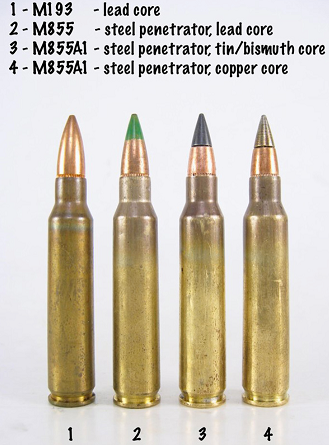
Another issue was the lack of expansion. The lead core in normal “ball” ammunition expands upon impact, which increases the diameter of the projectile and aids in transferring energy from the moving projectile to the target. The more energy is transferred, the greater the wound in the target and the more likely it is to stop that target.
Using a steel tip meant that the bullets no longer deformed, and therefore the energy transferred to the target was less than with 55 gr FMJ “ball” 5.56. In other words, the M855 ammunition is actually considered to be less effective against living targets than “ball” 55-grain bullet weight 5.56 NATO ammo. Or, put another way, standard lead ammunition rifle ammo is considered more deadly than M855.
I’ll have you know that in the hyper specific situation where we hit an enemy helmet from five hundred and fifty meters away, the M855 round is far more deadly than the M193 round, which would only be good from 500 meters away. Who cares about the performance against flesh when you’ve got that capability!
Technically, M855 is better at penetrating barriers like thin walls and car doors than normal 55gr lead 5.56 is, but this really isn’t an attractive characteristic for most normal shooters.
This is bad for home defense since you run a much higher risk of overpenetration through walls. Even if you’re not worried about overpenetration, M855 isn’t advantageous on soft targets, either. Because of the steel penetrator, M855 normally acts more like an ice pick when it hits soft tissue and just pokes a hole straight through. In other words, it’s not a great pick for stopping bad guys.
Here’s what overpenetration looks like in practice. EDIT: Sorry if the video isn’t embedding properly.
https://youtu.be/EDT5cGchLMU?si=NxnYGhJ9hT2K9TNE
I am not arguing that higher penetration is never something that we want from our guns. The reason why even the lightest CAS plane needs something like a 50 cal heavy machine gun, is because if you’re doing a strafing run of infantry hiding in a tree line from six hundred meters away you need great penetration of the foliage, while also having enough power to kill the infantry below. But the 50 cals can only achieve great penetration along with tremendous stopping power because they are exceptionally large rounds.
When it comes to smaller ammunition, you can’t magically have a round that slices through small branches, glass, thin metal, and the like, whilst also reliably expanding, deforming, and fragmenting upon impact with someone’s thigh. That’s not possible, and it’s also not really possible to have a 5.56 round with good penetration anyway, compared to the larger rounds from 50 cal guns, or even 30 cal guns. Arbitrarily deciding that you absolutely must have x level of penetration is something that needs to be justified, and talking about helmet penetration at six hundred meters ain’t it.
If it were the case that higher penetration and better marksmanship were what was required from the default assault rifle, then the M-16 would have been a disaster in Vietnam, and the M-14 would have been the saviour. In reality, the exact opposite was true, but the US Army looked to the past, saw the failure of the M-14, and said “let’s do that again.”
Now Back To Our Regularly Scheduled Program
National Interest (September 16th):
Summary and Key Points You Need to Know: Since February 2022, Ukraine has relied heavily on Western aid to resist the Russian invasion, including the use of U.S.-supplied M1 Abrams tanks. Despite its reputation as a reliable main battle tank, the Abrams has suffered heavy losses on Ukrainian soil, with up to 20 out of 31 tanks reportedly destroyed due to advanced Russian weaponry like the Kornet anti-tank missile.
The Abrams is too heavy to go over many bridges in Europe, and even more in the Middle East, and a great deal of open terrain. Below is a graphic from a US Military report on the future M1A3 Abrams showing the limited cross country mobility of the Abrams in various conditions.

Its cross country mobility is so poor that the US Military is designing the replacement, M1A3, to weigh about 30,000 lbs less. I have no faith that they’ll get there, but the new version is undoubtedly going to have even less armour. Its protection issue isn’t going away, although, again, no tank is actually indestructible, and if the expectations for the Abrams were based in reality, losing half the fleet wouldn’t be seen as so terrible.
However, as poor as the Abrams is doing in Ukraine, at least it showed up. That’s more than we can say for one massively overhyped piece of junk.
Why Don’t Wend Send the F-35 Stealth Fighter to Ukraine?
For the same reason why Lockheed Martin cries and shits their pants when anyone proposes a competitive flyoff involving the F-35 and contemporary jets. That’s why the (((Conservative Party of Canada))) tried to avoid a competitive flyoff before stealing our tax dollars for this piece of shit. That’s why the (((Liberal Party of Canada))) campaigned on doing a competitive flyoff, and then cancelled that as well and stole our tax dollars for this piece of shit all the same.
If F-35’s were sent to Ukraine they would accomplish nothing, while getting destroyed en masse both on the ground and in the air. It would be an even bigger propaganda disaster than BaroonGate, where the US Military spent days scrambling to destroy the Indiana Bottlecap Brigade’s hobby balloons. Or when they failed five times to even launch their hypersonic missiles and then ragequit their program, years after Iran of all countries had built their own.
The F-35’s “stealth” concept is a joke. While it is true that x-band radars can detect the plane only at decreased distances from the front and the back, VHF radars can detect these planes from hundreds of kilometers away, regardless of their shape. As a result, the F-35, or any other “stealth” plane, will be flying as low to the ground as all the other aircraft – except when hundreds of kilometers away from the frontlines and therefore outside of the enemy anti-air defenses anyway – because that’s the actual way that aircraft hide from radar. Breaking the laws of physics is very unreliable, but having some dirt between you and the nearest radar works every time. And if you’re hiding from radars using terrain mapping, then you really ought to have designed your airframe for aerodynamics, not imaginary stealth.
An equivalent of this fake stealth technology for the infantry would be this camera and projection system used in Mission Impossible. When I and others point out how totally infeasible this would be in a real war for a number of different reasons – can only work from a perfectly ideal angle and distance in front of the projector, requires perfectly smooth terrain, additional weight for the soldier, etcetera – the defenders of this bullshit accuse us of being technology hating Luddites.
Once you have removed the fraudulent stealth “bonus” from the F-35, all you are left with is an exceptionally draggy, overweight, unmaneuverable fighter that guzzles down fuel like the politicians who shill for these planes guzzle down their donors jizz. Contrary to asinine claims that “when a fourth generation fighter meets a fifth generation fighter, the fifth generation fighter wins,” you’d see plenty of “fifth generation” F-35’s getting blown up by SU-35’s, SU-27’s, or simply ground based anti-air defenses, while accomplishing nothing of value, despite it’s SenSoR FuSIoN ForCE mULtIPlYinG siTUaTioNAL aWArEnESs in the niNTh GeNEratTIonaL BatTLeFIeld.
Sending the F-35’s to Ukraine would lead to a propaganda victory for Russia, and a propaganda disaster for Weimerica so utterly devastating that it could permanently shift the balance of power in the world. That’s why I, someone who supports Russia, would love to see the Ukrainians flying the F-35, as long as they know where the ejection button is so we don’t have their blood on our hands.
However, this is all very confusing for dipshits who think Lockheed Martin sales brochures are based in reality, and support the zionist project in Ukraine. To them, it seems indefensible that we aren’t sending the F-35 SUPERWEAPON to the Ukrainians, instead sending them the old F-16’s. In comes National Interest with a long article full of copes, each more hilarious than the last. Finally, they end with this.
Lastly, consider that the longer Russia is engaged in a conflict, the weaker Russia becomes with respect to military resources and political capital.
A weaker Russia benefits the US. So, logically, it follows that the US would prefer for Russia to remain engaged in conflict indefinitely.
So, providing Ukraine with game-changing weapons systems may not ultimately be in the US’s best interest. Now, that’s a somewhat abstract, hypothetical, and cynical take – and may not reflect the strategy of the US war planners. But it’s something to think about.
Regardless, don’t expect the Ukrainians to receive any F-35s.
The F-35 can’t be sent to Ukraine, because it is so good that it would win the war too quickly.

The only precision strikes the F-35 will ever carry out are done against the taxpayers wallet. The only thing the “stealth” jet evades is competitive flyoffs and real combat. The only thing it is invisible to is friendly forces. It is a flying buzzword aggregator. It is in no way, shape, or form a real war machine.
Thirty years from now, if Weimerica is still standing, the F-35 will be allowed to see real combat for the first time. It will fail even harder than the Abrams has failed in Ukraine, and the NPCs who think Lockheed Martin’s science fiction is reality will scratch their heads in amazement as it is once again revealed that “boring” things like fuel consumption, rough field performance, kinematics, and numerical superiority are what win wars, instead of buzzwords.
Until such time as the political fallout from the F-35 Shitmobile’s inevitably spectacular combat failure can be minimized, presumably after a “sixth generation fighter,” has been created, expect them to stay in their hangars. Or perhaps it really is because they’re just so good that they’ll win every war they fight in too quickly. If you believe that, I’ve got a Ghost of Kiev to sell you.









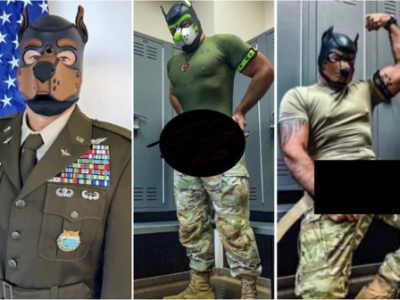




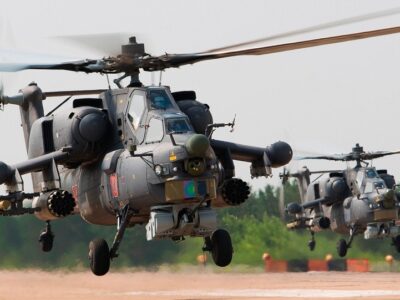

The Youtube channel “Operational Art of War” is the best channel ive seen for explaining this war and why it progresses the way it does.
It’s safe to say there has always been a political bent to producing these weapon systems and keeping certain conflicts going when they should have never been started. When will the West ever get over the WW2 victory sugar high? Either when unescapable bankruptcy finally happens or when the third world finally replaces all of the founding European stock.
“He’s probably referring to APFSDS rounds, which are essentially giant darts. They’re good for direct hits on heavily armoured tanks, and next to useless against anything else.”
The funny thing is that India of all countries has a munition for it’s Arjun MBT that is actually designed for urban fighting. It’s able to penetrate reinforced concrete, and it has a thermobaric explosive warhead.
And it has the most hilarious name in the world – the “120mm penetration cum blast.”
I think we have to concede that the pajeets are indeed a superpower.
The Pajeet’s cum blaster is indeed a superior anti-infantry round than anything the US Army has.
There is nothing wrong with the tank, but it takes 18 months to get a soldier trained on how to properly use the tank and these Ukraine guys can’t possibly have that training in time when they are used as cannon fodder.
Also if you don’t do combined air land and sea warfare like the USA does, then any tank is left exposed to air attack.
I’ve also never heard of anyone with combat experience talk about how they wished the 5.56 was an even smaller round. They usually want to go back to the .308.
I don’t understand why so many pro white people support Russia anyways, they have done the most for white genocide with their ww2 behavior. They are just as much of a Jew hotspot as the USA ever dreamed of being, and in fact most of our worst Jews like soros are the Russian type. If they defeat Ukraine and do their “denazification” they will do another holodomor totally based… not.
“There is nothing wrong with the tank.”
Well sure, it uses multiple times more fuel, requires far more in-field maintenance, and has ammunition ill-suited to the actual tasks it’s asked to perform, but other than these critically important things, there is nothing wrong with the tank.
“Also, if you don’t do combined air land and sea warfare like the USA does, any tank is left exposed to air attack.”
The Ukrainians are using their tanks just fine. The problem is that they are fighting against a real military, not a paper tiger like the Iraqis, or a glorified militia.
“I’ve also never heard anyone with combat experience talk about how they wished the 5.56 was a smaller round. They usually want to go back to the .308.”
Sure thing bro. That’s why the M-14 was a disaster in Vietnam, while the M-16 was a triumphant success. Soldiers really enjoy having 20 round magazines instead of 30 round magazines, and carrying less ammunition with a heavier gun. Don’t listen to any of them who tell you otherwise.
“Many of our worst Jews like soros are the Russian type.”
Soros entirely supports ZOGkraine, which has a Jew comedian dictator, and a literal tranny PR director.
I won’t go into an effortpost to defend the F35. It’s a good-ish but deeply flawed aircraft.
But why do you assume stealth is an American humbug, when both Russia and the Chinese are heavily investing into decreasing their airframes’ RCS?
Regarding the argument you made; I haven’t heard stealth’s vulnerability to early warning radars being brought up against it in a very long time. Probably because no official source ever claimed the contrary, so it’s really not a “gotcha”; not such a big issue if you understand how radars work; and all the early 2000s journo cranks like Carlo Knope have been shamed into silence.
You keep referring to a reduction in visibility to certain radars from certain aspects as “stealth.” This is odd, since those very same official sources you refer to will admit that, in any real conflict, the F-35 will use terrain mapping to hide from radars, something that negates the entire concept.
In the meantime, politicians like Andrew Scheer, or Donald Trump, will constantly refer to the plane as “invisible to radar.” Since the plane is too shitty to ever be subjected to a competitive fly off or a real war, the marketing materials are highly relevant to the discussion, since the sale or rejection of the plane takes place entirely through it’s purported (imaginary) abilities.
As for other countries reducing RCS, you could have thrown in the Eurofighter and Rafale. Making very small compromises to your jet in order to increase the difficulty of tracking for an incoming radar missile makes perfect sense. Going full retard and pretending that your plane is invisible, then crying and shitting your pants when anyone suggests a competitive fly off, let alone realistic testing of your claims, is not the action of a competent, self-assured design team ready to take on the Mars landing, but a bunch of incompetent used-jet fighter salesmen.
I don’t know who this “Carlo Knope” character is, but I doubt that he’s been shamed into silence by the F-22’s sole air to air kill coming against a kids balloon, and the F-35 somehow accomplishing even less. Good day, sir.
>“That’s why I, someone who supports Russia”
Why? Why do some White nationalists support a mongrel Eastern horde who believe rape is a method of military discipline?
They’ve performed terribly in this war, as they have done in most others.
Why support this awful country? Russia is a shithole.